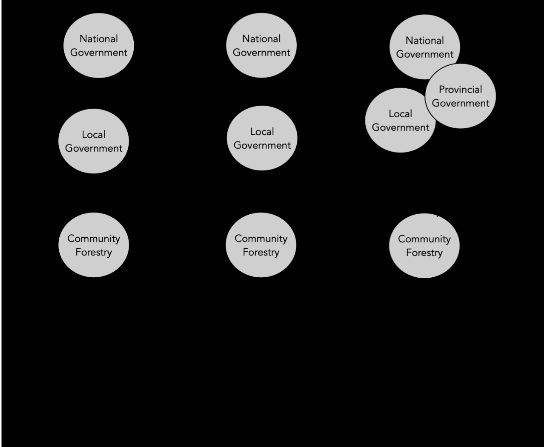When the Maoist rebellion was attacking all aspects of state and society in the decadal conflict that started in 1996, community forestry (CF) was one of the few things that were not touched upon by this violent movement. Indeed, the Maoists embraced and supported CF as the very model of collective action and benefit-sharing which they wanted to create everywhere in the country through the ‘revolution’. Various independent studies supported that Nepal’s CF remained resilient in times of conflict.
Formally started over four decades ago in the aftermath of Himalayan degradation crisis, Nepal’s CF system has truly come of age. With over 20,000 community forestry user groups (CFUGs) across the country, and with over 2 million families participating directly, this system has become the country’s largest platform of civic engagement as well as a solid foundation of local democracy. This movement is also positively correlated with the increase in forest cover to 44%, as some remote sensing studies show. This system is now under stake when the government is trying to introduce a new forest law as part of the wider legislative reform required by the new constitution. An important question that now arises is - how this time-tested and flagship development success of Nepal is being impacted by a proposed change in the forestry legislation.
 New Forest Bill
New Forest Bill
After the historic Constitution in 2015, Nepal’s parliament is updating over 300 legislations of the country to align the legislative system with the new Constitution. Forest Act 1993, which is seen as one of the most progressive in the world in terms of offering rights to local communities, is also one of such legislations that are being replaced with a new one, and the Ministry of Forest and Environment (MOFE) has already drafted a bill which is entering the parliament soon.
It is not just the new Constitution that warrants changes in the forestry legislation in Nepal; the profoundly changing social and economic contexts reshaping forest and society relations also warrant legislative improvement in community forestry. And as a matter of rule, periodic changes in the forest legislation are necessary to enable positive forest society interface within the system of community forestry in Nepal. As the government looks to finalize the forest bill, there are at least five important aspects which need to be seriously considered to make any legislative changes prudent.
Resource ownership
Nepal’s public forests are regarded as ‘national forests’ as per the current law. Community forest is a part of national forest formally handed over to CFUG registered with the District Forest Office. The current Forest Act 1993 allows communities to enjoy perpetual rights over community forests once handed over to them. The government can suspend a CFUG in case of blatant mismanagement of community forest, but there is a compulsory legal provision to re-transfer the right to CFUG by reorganizing the group. Such a perpetual and sustained right of access to forest has been the key foundation for the success of community forestry in Nepal, and deviation from this foundational legal arrangement can jeopardize the achievements made to date.
Who regulates CFGUs?
With federal Constitution and the election of three layers of the government - federal, provincial, and local - the question of who will regulate the community forestry system should be explored in the new light. The pre-federal arrangement is that District Forest Office, a district level unit of the national government Department of Forest, is authorized to legally register the CFUG as an institution to manage CF. This office is also legally empowered to transfer a part of national forest to a CFUG as per a forest operational plan, which forms a part of the contract between the CFUG and the government regarding the management and utilization of community forests. No local or subnational government arrangements are part of CF governance. Now in the new federal system, there is a strong and enlarged system of local government, with much greater powers to govern, as defined in the Constitution itself. Forest is also in the concurrent list of the Constitution, with community forestry related matters being the responsibility of local and provincial governments. Given this situation, it is prudent to offer local governments the power to register CFUGs and regulate their institutional aspects. The new Divisional Forest Office, under the provincial government, could be authorized to approve forest operational plans of CFUGs and then to transfer the forest rights to CFUGs. Any matters related to large wild animals, which are not common in community forestry but in national parks and conservation areas, remain the responsibility of the federal government.
Revenue sharing
Recently, Local Government Operations Act has been promulgated by the parliament and this has also touched on the subject of revenue sharing in community forestry system. It has required CFUG to pay 10% tax to local government on the sale of forest products by CFUGs to markets. Instead of revenue sharing arrangement, it would be better to have taxation arrangements based on financial transactions and profits. In time to come, CFUGs are likely to take more commercial path, and taxation policy for CFUGs can also be made similar to other businesses. As a matter of principle, taxes from community forestry should be shared among governments proportionately to the regulatory burden, in addition to the base tax levied by the federal government. An expert team can calculate figures through an assessment of constitutionally prescribed roles of the three layers of government, which can then be discussed with representatives of key stakeholders. A proposal for CFUG to pay taxes to local and provincial government may sound upraising to CFUGs, but it is important to reposition community groups in the new federal, democratic system of governance, in a marked shift away from the old Panchayat system when community forestry was devolved beyond local Panchayat governments.
Service delivery
One of the critical aspects of community forestry development in Nepal has been how technical and institutional development services are managed. Nepal’s forest governance history as well as the Forest Act 1993 has authorized the Department of Forest as not only the regulator of community forestry, but also the provider of technical services - such as those related to forest assessment, planning, and management. While this practice has allowed communities to seek technical service from the government when there is limited alternative service outside, this arrangement has problematically mixed up regulatory/monitoring role and service delivery role, creating conditions for rent-seeking and the lack of responsiveness in the delivery of service itself. Based on this lesson, and also recognizing the principle of separation of technical service delivery and regulatory roles, CFUGs’ institutional autonomy should be respected and strengthened when it comes to identifying and choosing technical and institutional development service from the wider service industry. Indeed, there is a need to provide a clear and enabling regulatory arrangement for the registration and operation of service providers outside of the government system, while new Divisional Forest Office retains the power to monitor the quality and regulate the technical service. Technical and regulatory roles thus must be de-coupled.
Monitoring and regulatory compliance
CFUGs have developed excellent institutional capacity for self-governance, and have functioned well even without active monitoring from the government. Internal democratic practice and accountability procedures have evolved to underpin the institutional capacity of CFUGs. Yet, community system of governance cannot remain isolated from the larger system of governance, in which democratic oversight and regulatory compliance are essential aspects of forest governance. Until now, the Department of Forest, through its DFO, has retained the legal responsibility to monitor the performance of CFUGs. CFUGs are required to submit annual report covering institutional and forest-related activities of the fiscal year. In the new federal system, it is prudent to have multi-level monitoring and compliance mechanisms, assigning complimentary and clear roles to different levels of governments. Local governments should be authorized to monitor CFUG institutional practices - such as periodic general assembly, social inclusion, fairness in benefit distribution and so on. Reporting of these aspects should be done in an annual basis. The provincial government should monitor forest management related practices of the CFUGs, through less burdensome and less frequent reporting, perhaps three-yearly reporting of forest management and condition.
Conclusion
The moment to enact a new forest legislation in the newly federalized Nepal represents a new and important milestone in the six decades of community forestry evolution in the country. The new forest bill is an exciting opportunity to update and institutionalize community forestry, which was invented in the era of autocratic Panchayat system and was given a significant update after the advent of multiparty political system in 1990. With four decades of history, community forestry has produced diverse groups of actors - from advocates to critics, so it is important to see CF in a fresh light. Community forestry should neither be romanticized as a domain of community sovereignty, nor as something to be overly regulated by the state. The new forest bill must retain and consolidate the important institutional autonomy that community forestry has gained through years. It is also important to craft democratic connections between CFUG practice and the new federal system of governance. An institutional autonomous community forestry democratically connected to federal system of governance can offer a solid foundation for environmental sustainability and community prosperity in Nepal.

